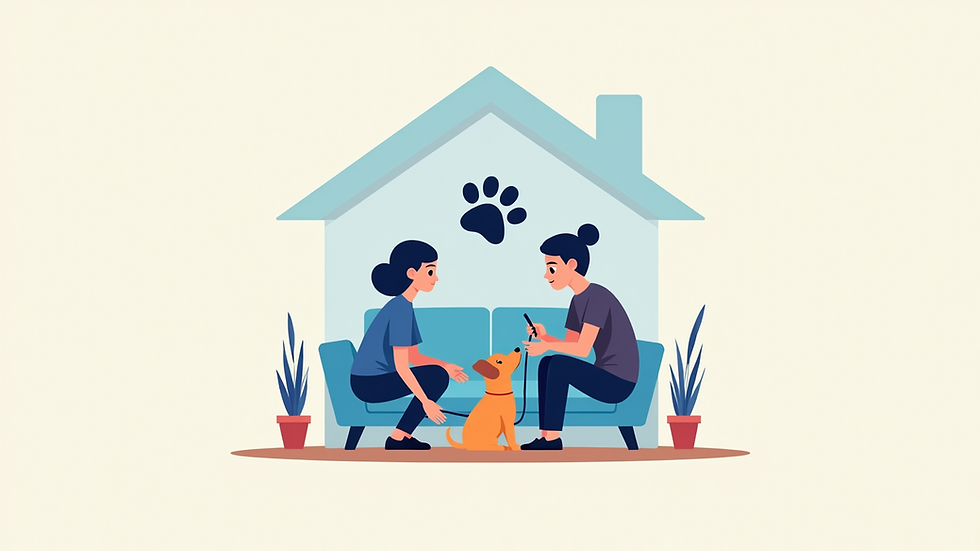Benefits of Private Dog Training Sessions
- Donte B.
- 5 days ago
- 4 min read
Bringing a dog into your life is one of the most rewarding experiences. But let’s be honest - it can also be a bit overwhelming. Whether you’re juggling a busy schedule, managing a household with kids, or navigating the challenges of a new puppy, training your dog can feel like a huge task. That’s where personalized dog training sessions come in. They offer a tailored approach that fits your unique situation and your dog’s personality. I’ve seen firsthand how these sessions can transform not only a dog’s behavior but also the bond between pet and owner.
Why Choose Personalized Dog Training Sessions?
Personalized dog training sessions are designed just for you and your furry friend. Unlike group classes, these sessions focus entirely on your dog’s specific needs, temperament, and learning pace. This means the trainer can adapt techniques and exercises that work best for your dog, making the process more effective and enjoyable.
For example, if your dog struggles with leash pulling, the trainer can spend extra time on that issue without rushing through other topics. Or if your pup is shy or anxious, the trainer can use gentle, confidence-building methods tailored to their personality. This one-on-one attention helps your dog learn faster and feel more comfortable.
Plus, personalized sessions fit better into busy schedules. You can book times that work for you, and the trainer can come to your home or meet at a convenient location. This flexibility is a game-changer for anyone balancing work, family, and pet care.

How Personalized Dog Training Sessions Benefit Busy Pet Parents
If you’re someone who works long hours, commutes, or travels often, you know how hard it is to find time for consistent dog training. Personalized dog training sessions offer a practical solution. Here’s how:
Focused Attention: The trainer works directly with you and your dog, addressing your specific concerns without distractions.
Flexible Scheduling: Sessions can be arranged around your work hours or family commitments.
Home Environment Training: Training in your own home means your dog learns in the environment where they’ll be expected to behave.
Ongoing Support: Many trainers offer follow-up sessions or check-ins to keep progress on track.
For families with kids, personalized training ensures your dog learns to be gentle and safe around children. Trainers can teach your dog commands and behaviors that protect both your kids and your pet, creating a harmonious household.

Is it worth paying someone to train your dog?
This is a question I hear a lot, and my answer is a resounding yes. Investing in professional training saves you time, stress, and frustration in the long run. Here’s why:
Expertise: Trainers understand dog behavior and psychology. They know how to communicate with your dog in ways that you might not.
Customized Plans: A trainer creates a plan that fits your dog’s breed, age, and personality.
Faster Results: Professional guidance helps you avoid common mistakes and accelerates learning.
Better Behavior: Well-trained dogs are happier and safer, which means fewer accidents and less worry.
Peace of Mind: Knowing your dog is trained by a trusted expert gives you confidence, especially when you’re away.
Think about it this way - paying for training is an investment in your dog’s well-being and your family’s happiness. It’s a gift that keeps on giving.
What to Expect During Personalized Dog Training Sessions
When you sign up for personalized dog training, the first session usually starts with an assessment. The trainer will observe your dog’s behavior, ask about your goals, and discuss any challenges you’re facing. This helps them create a tailored training plan.
Sessions typically include:
Basic Obedience: Commands like sit, stay, come, and heel.
Behavior Correction: Addressing issues like barking, jumping, or chewing.
Socialization: Helping your dog feel comfortable around people and other animals.
Leash Training: Teaching your dog to walk calmly on a leash.
Problem-Specific Training: Customized exercises for unique challenges.
The trainer will also teach you how to reinforce these behaviors at home. This partnership is key to lasting success.
How to Choose the Right Trainer for Your Dog
Finding the right trainer is just as important as the training itself. Here are some tips to help you choose:
Look for Experience: Trainers with a solid background and positive reviews are a good bet.
Ask About Methods: Positive reinforcement is the most effective and humane approach.
Check Credentials: Certifications from reputable organizations show professionalism.
Meet the Trainer: A good trainer will listen to your concerns and explain their approach clearly.
Trial Session: Some trainers offer a trial session to see if it’s a good fit.
Remember, the goal is to find someone who understands your dog and supports your training goals.
Taking the Next Step with Private Dog Training Sessions
If you’re ready to see real progress with your dog, consider exploring private dog training sessions. These sessions provide the personalized attention and expert guidance that busy pet parents, families, and first-time dog owners need. With the right support, you’ll enjoy a well-behaved dog and a stronger bond that makes every day more joyful.
Training your dog doesn’t have to be a solo journey. With personalized help, you can overcome challenges, build confidence, and create a happy, safe home for your furry family member. Why wait? Your dog’s best behavior is just a session away!







Comments